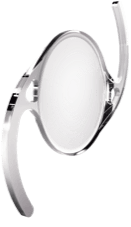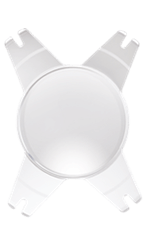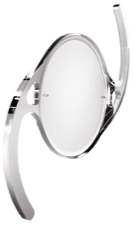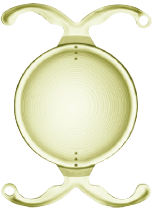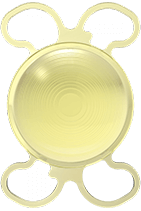Intraocular Lenses for Cataract Surgery
Cataract surgery is one of the most commonly performed surgeries in the world, with approximately 10 million people undergoing the procedure every year. Any surgical or invasive procedure carries risks. Before proceeding, you should seek a second opinion from an appropriately qualified health practitioner. With cataract surgery, your eye’s clouded lens is removed and replaced with a clear artificial lens implant, called an intraocular lens or IOL. There are many IOL technologies available to best suit your visual and lifestyle needs.

Choosing the Best IOL Implant for You
During cataract surgery, the clouded natural human lens is removed and replaced with an artificial lens known as an intraocular lens (IOL). Intraocular lens implants are prescription lenses that are placed in your eye to help restore your eye’s focusing power once your natural lens has been removed during cataract surgery.
The three main IOL implants are:
- Monofocal IOLs – these have one focal point and help correct a specific range of vision (either near, intermediate or far).
- Toric IOLs – these IOL implants that have advanced features to help correct astigmatism.
- Trifocal IOLs – these are surgical lenses that help correct for near, intermediate and distance vision. Some of them are also toric IOLs that can simultaneously correct astigmatism.
The best IOL implant for you depends on your lifestyle, vision needs, eye anatomy, budget, and ophthalmologist’s recommendations.
Monofocal IOLs
Standard monofocal IOLs are the most common IOL implants; they can provide you with clear vision and sharp focus at a specific distance, enabling you to see well-defined images at that distance. Monofocal IOLs can’t give you clear vision over a full range of distances (like the natural lens does) or correct for astigmatism. Glasses/contact lenses are still needed after cataract surgery to enable clear vision at the distances that are uncorrected for.
Monofocal Toric IOLs
Astigmatism correction can be incorporated into IOL implants known as toric monofocal IOL implants, that need to be placed in a specific orientation. To enable them to correct astigmatism, toric monofocal IOLs have different focusing powers in different regions (meridians) of the lens. Toric monofocal IOL implants, like standard monofocal IOL implants, don’t allow you to see both near and far away without glasses/contact lenses; however, the necessity and strength of prescription glasses/contact lenses will likely decrease after the surgery.
Trifocal IOLs
Trifocal IOLs are specifically designed to help improve vision at intermediate distances (important for things like cooking, facial recognition and unlocking doors) whilst also enabling clear vision at near and far distances. Trifocal IOL implants can reduce your dependence on glasses post-surgery. Some trifocal lenses are toric and can correct for astigmatism whilst addressing the cataract, hyperopia or myopia. However, trifocal IOL implants might create glare and halos/rings around lights at night.
DOs and DON’Ts After Cataract Surgery
Follow all the instructions given to you after your cataract surgery about how to care for your eye and what you should/shouldn’t do. Some general recommendations after cataract surgery are listed below.
You should:
- Use the eye drops exactly as prescribed.
- Follow instructions regarding your eye-patch and medications (such as painkillers).
- Watch out for symptoms of infection; let your ophthalmologist know if you have any concerns or if you experience pain/sensitivity to bright lights.
- Minimise exposure to eye irritants like dust, wind and pollen for around one week, and wear sunglasses outdoors.
- Shower/bathe with care.
- Wait until a few hours have passed before looking at screens eg. watching TV or working on the computer.
You should not*:
- Rub your eyes.
- Do strenuous activities such as exercise or housework.
- Allow soap or shampoo to get in your eyes.
- Swim for 4-6 weeks.
- Wear eye make-up for at least four weeks after surgery.
- Drive until you have been told by your doctor that it is safe.
*If you’re unsure, ask your ophthalmologist about when these activities can be resumed.
FAQs
How long do intraocular lenses last?
Depending on your eye health and the type of IOL implant used, your IOL should last a lifetime because IOL implants are made from durable clear material (silicone or acrylic).
Can intraocular lens implants be replaced?
Although intraocular lens implants can be replaced, it is rarely needed.
Does astigmatism get worse after cataract surgery?
Astigmatism can potentially worsen if it is not corrected during cataract surgery.
Does cataract surgery change eye colour?
No. Cataract surgery does not affect the iris, which is the part of the eye that has pigmentation and determines eye colour.
How bad do cataracts need to be for surgery?
Surgery is recommended when the cataracts grow and the symptoms interfere with your daily living. If your cataracts prevent your doctor from examining your eyes or treating other eye problems, it’s also best to consider cataract surgery.
Is anaesthesia used in cataract surgery?
Yes. Cataract surgery is carried out under local or topical anaesthesia. You’ll be awake during surgery but because your eye is numb, you won’t feel pain. Usually, topical local anaesthetic eye drops or gel are applied onto the surface of the eye before the operation. Alternatively, you might get an injection of a local anaesthetic around or behind the eye. General anaesthesia is uncommon for cataract surgery.
Is cataract surgery covered by medical insurance?
Please enquire with your insurance provider as to whether or not you are covered for your cataract surgery and how much cover will be provided.
When can you exercise after cataract surgery?
Always ask your ophthalmologist before resuming any form of exercise.
This product is not available for purchase by the general public. Any surgical or invasive procedure carries risks. Before proceeding, you should seek a second opinion from an appropriately qualified health practitioner.
